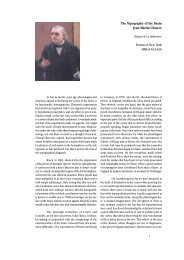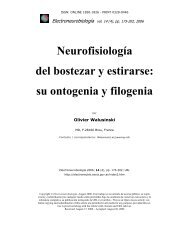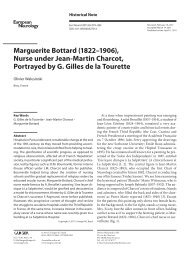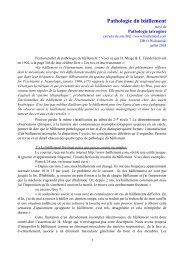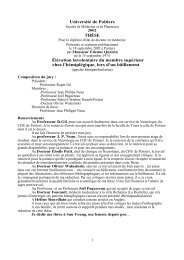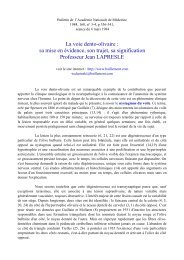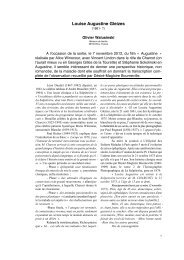You also want an ePaper? Increase the reach of your titles
YUMPU automatically turns print PDFs into web optimized ePapers that Google loves.
History of neurology<br />
<strong>Augustin</strong> <strong>Morvan</strong> (1819–1897), a little-known rural physician<br />
and neurologist<br />
<strong>Augustin</strong> <strong>Morvan</strong> (1819–1897), mé<strong>de</strong>cin <strong>de</strong> campagne et neurologue<br />
méconnu<br />
O. Walusinski a, *, J. Honnorat b,c,d,e<br />
r e v u e n e u r o l o g i q u e 1 6 9 ( 2 0 1 3 ) 2 – 8<br />
a<br />
28160 Brou, France<br />
b<br />
Lyon Neuroscience Research Center, Inserm U1028/CNRS UMR 5292, 69372 Lyon, France<br />
c<br />
Université Clau<strong>de</strong>-Bernard Lyon-1, 69372 Lyon, France<br />
d<br />
Hôpital neurologique Pierre-Wertheimer, hospices civils <strong>de</strong> Lyon, 59, boulevard Pinel, 69677 Bron, France<br />
e<br />
Centre <strong>de</strong> référence maladie rare « syndromes neurologiques paranéoplasiques », 69677 Bron, France<br />
i n f o a r t i c l e<br />
Article history:<br />
Received 28 February 2012<br />
Received in revised form<br />
21 April 2012<br />
Accepted 24 April 2012<br />
Published on line 2 July 2012<br />
Keywords:<br />
History of neurology<br />
<strong>Morvan</strong>’s syndrome<br />
Syringomyelia, Myxoe<strong>de</strong>ma<br />
Myokymia<br />
Channelopathy<br />
Mots clés :<br />
Histoire <strong>de</strong> la neurologie<br />
Syndrome <strong>de</strong> <strong>Morvan</strong><br />
Syringomyélie<br />
Myxœdème<br />
Myokimie<br />
Channelopathie<br />
Available online at<br />
www.sciencedirect.com<br />
a b s t r a c t<br />
<strong>Augustin</strong> <strong>Morvan</strong> (1819–1897) was a contemporary of Jean-Martin Charcot who practised<br />
medicine in rural Brittany. A perspicacious and astute clinician, he <strong>de</strong>scribed three clinical<br />
pictures not previously isolated: in 1875 the semiology of myxoe<strong>de</strong>ma, in 1883 the neurological<br />
semiology of syringomyelia which he called ‘‘paretic analgesia of the upper extremities’’,<br />
and finally in 1890 the semiology of ‘‘fibrillary chorea’’, currently consi<strong>de</strong>red a<br />
mo<strong>de</strong>l of synaptic pathology involving immunological damage to potassium channels and<br />
causing (as perfectly <strong>de</strong>scribed by <strong>Morvan</strong>) myokymia, autonomic nervous system disturbances<br />
and agrypnia. ‘‘Fibrillary chorea’’ is today known as <strong>Morvan</strong>’s syndrome and linked<br />
to limbic encephalitis.<br />
# 2012 Elsevier Masson SAS. All rights reserved.<br />
r é s u m é<br />
* Corresponding author.<br />
E-mail address: walusinski@baillement.com (O. Walusinski).<br />
0035-3787/$ – see front matter # 2012 Elsevier Masson SAS. All rights reserved.<br />
http://dx.doi.org/10.1016/j.neurol.2012.04.005<br />
Contemporain <strong>de</strong> Jean-Martin Charcot, <strong>Augustin</strong> <strong>Morvan</strong> (1819–1897) exerça, lui, la mé<strong>de</strong>cine<br />
dans la campagne bretonne. Perspicace et fin clinicien, il décrivit trois tableaux<br />
cliniques non individualisés auparavant : en 1875, la sémiologie du myxœdème, en 1883,<br />
la sémiologie neurologique <strong>de</strong> la syringomyélie qu’il baptisa « paréso-analgésie <strong>de</strong>s extrémités<br />
supérieures », puis, en 1890, la sémiologie <strong>de</strong> « la chorée fibrillaire », reconnue<br />
actuellement comme un modèle <strong>de</strong> pathologie synaptique par atteinte immunitaire <strong>de</strong><br />
l’activité <strong>de</strong>s canaux potassiques, responsable comme l’avait parfaitement décrit <strong>Morvan</strong>,<br />
<strong>de</strong> myokimies, <strong>de</strong> troubles neurovégétatifs, d’agrypnie et apparentée à « l’encéphalite<br />
limbique ».<br />
# 2012 Elsevier Masson SAS. Tous droits réservés.
<strong>Augustin</strong> <strong>Morvan</strong>, of <strong>Lannilis</strong> in Brittany (1819–1897), was a<br />
rural physician working in his native region in the 19th<br />
century. By an exceptional fate, he still has his name<br />
associated with a syndrome listed in the PubMed medical<br />
database. A keen observer and astute clinician, he <strong>de</strong>scribed<br />
myxoe<strong>de</strong>ma in 1875, then the clinical signs of syringomyelia,<br />
which he named in 1883 ‘‘paretic analgesia of the upper<br />
extremities’’ (known as <strong>Morvan</strong>’s disease among his contemporaries).<br />
In 1890, he <strong>de</strong>scribed a muscular pathology which he<br />
named ‘‘fibrillary chorea’’, currently referred to as <strong>Morvan</strong>’s<br />
syndrome, or as autoimmune channelopathy, and linked to<br />
limbic encephalitis.<br />
1. <strong>Morvan</strong>, from Brittany to Paris<br />
<strong>Morvan</strong> died on 20 March 1897 in Douarnenez at the age of 78,<br />
after five years of progressive physical and intellectual <strong>de</strong>cline<br />
secondary to hemiplegia. His funeral service brought together<br />
an immense crowd of peasants, colleagues and important<br />
figures in Brittany. All the speeches given that day bear<br />
witness to his flawless <strong>de</strong>votion, his far-reaching reputation<br />
and his extensive medical knowledge, gained over 45 years of<br />
practice. <strong>Morvan</strong> was born in a peasant family on 7 February<br />
1819 in the village of Foz-Nevez, which is part of the city of<br />
<strong>Lannilis</strong> (Aberwrach, Brittany). He was the el<strong>de</strong>st of eight<br />
children. After his studies at the military medical school in<br />
Brest, he was named a Marine surgeon on 18 June 1839, but<br />
resigned a few months later as he was unable to tolerate<br />
seasickness! After completing his training in Paris, he<br />
obtained a house officership there in 1844, thus becoming<br />
an interne along with Ludger Lunier (1822–1885) and Paul Broca<br />
(1824–1880). On 11 March 1847, he <strong>de</strong>fen<strong>de</strong>d his thesis, entitled<br />
‘‘Varicose aneurism’’ (De l’anévrysme variqueux), to a jury that<br />
inclu<strong>de</strong>d his teacher Auguste Nélaton (1807–1873). Despite the<br />
appeal of working in Paris, he planned to set up his practice in<br />
Brest. When he informed his mother of his plans, she burst<br />
into tears. According to legend, <strong>Morvan</strong> immediately unhitched<br />
his cabriolet and followed the dictates of filial love. He<br />
<strong>de</strong>ci<strong>de</strong>d to settle <strong>de</strong>finitively in <strong>Lannilis</strong>, a city of 3000<br />
inhabitants. He quickly established a reputation and his<br />
fellow citizens pressed him to become mayor, then a regional<br />
administrator in 1857. In 1871, he was elected Deputy for the<br />
Finistère region un<strong>de</strong>r the new Third Republic, as part of a<br />
group known as the ‘‘Republican list for or<strong>de</strong>r and peace’’.<br />
Famous for only providing free medical care during his term as<br />
Deputy, <strong>Morvan</strong> voted for the resignation of Adolphe Thiers<br />
(1797–1877) and supported the legalisation of civil funerals.<br />
But he is most associated with the <strong>Morvan</strong>-Roussel law, the<br />
first concerned with unfortunate children and aimed at<br />
protecting those who had been abandoned as well as young<br />
mothers. He personally <strong>de</strong>veloped this law at a time when<br />
public opinion reflected people’s fears about their collective<br />
responsibilities. He thereby gave a social orientation to<br />
legislative power, and later inspired other progressive physicians<br />
such as Désiré-Magloire Bourneville (1840–1909). His<br />
legislation also led to the law on obligatory public assistance<br />
(Anonymous, 1897; Le Gallo, 1992; Létienne, 1897; Robert and<br />
Cougny, 1889). Despite striving only to ease suffering<br />
and correct injustice, this distinguished practitioner was<br />
r e v u e n e u r o l o g i q u e 1 6 9 ( 2 0 1 3 ) 2 – 8 3<br />
constantly confronted with the superstitions of his patients<br />
and pressure from clergy. He was also subject to <strong>de</strong>famation<br />
and hostile acts, some taking place in front of his home. An<br />
example of the slogans attacking him: ‘‘People of <strong>Lannilis</strong>, you<br />
have elected an unworthy mayor, you have voted for a<br />
<strong>de</strong>fen<strong>de</strong>r of prostitutes. Doctor <strong>Augustin</strong> <strong>Morvan</strong> of <strong>Lannilis</strong> is<br />
the father of prostitutes’’ (Desse, 1957). Undoubtedly because<br />
of this <strong>de</strong>famation, he was not re-elected and stopped his<br />
political activities. Nonetheless until the end of his life, he<br />
doctored tirelessly. He was known throughout Brittany–‘‘An<br />
aotrou <strong>Morvan</strong>’’ or Monsieur <strong>Morvan</strong>–pronounced with<br />
fervour and respect by countless patients.<br />
2. Myxoe<strong>de</strong>ma in lower Brittany<br />
After writing to Jean-Martin Charcot (1825–1893) in 1875,<br />
<strong>Morvan</strong> published his correspon<strong>de</strong>nce in the Gazette Hebdomadaire<br />
<strong>de</strong> Mé<strong>de</strong>cine et <strong>de</strong> Chirurgie in 1881: ‘‘I believe I have<br />
observed an as-yet un<strong>de</strong>scribed disease in Brittany, but I fear I<br />
am lacking in knowledge and thus appeal to your expertise.<br />
This disease is specific to women; at least until now I have not<br />
encountered it in men. It is characterised by anasarca and<br />
incomplete paralysis, but does not entail muscular atrophy or<br />
<strong>de</strong>gradation of mental faculties. In other words, it is not<br />
explained by any known disease, no more so than oe<strong>de</strong>ma is<br />
explained by an infection of the heart or kidneys. Facial<br />
swelling, which coinci<strong>de</strong>s with slow speech and hoarseness, is<br />
pathognomonic. [...] There is always pronounced muscular<br />
weakness, but never to the point that it prevents walking. [...]<br />
All of our patients are very sensitive to cold’’. In 1875, <strong>Morvan</strong><br />
was thus the first to <strong>de</strong>scribe the semiology of what would<br />
become hypothyroidism. He continued: ‘‘If this disease has<br />
not been <strong>de</strong>scribed, I intend to gather my eight observations<br />
together into a little study. I would be greatly obliged if you<br />
would allow me to call upon your erudition, if necessary. [...]<br />
Not obtaining a response as early as we wished, and believing<br />
that perhaps Monsieur Charcot, with whom we had no<br />
previous contact, reserved his time for more pressing<br />
obligations, we called upon our old colleague Verneuil. [...]<br />
We received a response from Monsieur Charcot. He apologised<br />
for not responding earlier, but he took advantage of the time<br />
elapsed to search his memory and the medical publications<br />
over and over, where he found nothing similar. He conclu<strong>de</strong>d<br />
by strongly advising us to publish our observations. We had<br />
not yet published anything and would not have at any rate, as<br />
we were lacking in material and hoped that time would<br />
provi<strong>de</strong> us with further information. Then, in May of this year,<br />
we fell upon an article by Dr Merklen published, or rather<br />
republished in the Gazette Hebdomadaire <strong>de</strong> Mé<strong>de</strong>cine et <strong>de</strong><br />
Chirurgie and entitled « Pachy<strong>de</strong>rmatous cachexia (cretinoid<br />
state, myxoe<strong>de</strong>ma) ». Out in the countrysi<strong>de</strong> where we live, La<br />
Gazette is our only journal. After noting that William Gull<br />
(1816–1890) had presented similar observations in London in<br />
1873, in 1881 <strong>Morvan</strong> put forward 15 observations of women<br />
around 50 years old and exhibiting the same symptoms. He<br />
noted sensitivity to cold and measured their temperature at<br />
36 8C; he also ma<strong>de</strong> mention of stubborn constipation, pulse<br />
rates slowed to 50 and slowness in thinking. He noted that,<br />
contrary to his initial finding, men and children can be
4<br />
affected. He conclu<strong>de</strong>d with a pathophysiological discussion:<br />
‘‘This appears to be an oe<strong>de</strong>ma of neuro-paralytic origin with<br />
vasomotor paralysis’’ [...] ‘‘We conclu<strong>de</strong> that myxoe<strong>de</strong>ma is a<br />
central nervous system disease that only affects the motor<br />
nerves (in both the somatic and autonomic systems) which are<br />
paralysed. Thus it does not affect the portion of the central<br />
nervous system related to mental faculties or the sensory<br />
nerves’’. He conclu<strong>de</strong>d these first observations of myxoe<strong>de</strong>ma,<br />
which were perfectly relevant from a clinical perspective, by<br />
alluding to his disappointment at the failure of all his<br />
therapeutic efforts (<strong>Morvan</strong>, 1881).<br />
3. From paretic analgesia of the upper<br />
extremities with panaris inflammations to<br />
syringomyelia<br />
With the clinical astuteness and observational precision that<br />
established the reputation during the same period of Charcot<br />
at La Salpêtrière Hospital, <strong>Morvan</strong> collected a series of<br />
observations of a disease that once again appeared to him<br />
as not yet isolated. From his first publication in 1883 in the<br />
Gazette Hebdomadaire <strong>de</strong> Mé<strong>de</strong>cine et <strong>de</strong> Chirurgie, he used a<br />
picturesque style (one that he maintained from that point<br />
forward) to <strong>de</strong>scribe his first patient: ‘‘The first case we<br />
observed dates back 25 or 30 years. It involved a 60-year old<br />
man who came to us with a panaris inflammation on one of<br />
his fingers. His hand and entire forearm were swollen. We<br />
observed necrosis of the finger at the nail and proposed an<br />
incision to the patient for its extirpation. Since the patient only<br />
accepted with mo<strong>de</strong>rate enthusiasm, we ad<strong>de</strong>d that the<br />
incision would be lightening fast, that he would not have time<br />
to suffer. We procee<strong>de</strong>d with the incision, which involved a<br />
rather wi<strong>de</strong> cut. How surprised we were to observe the calm<br />
<strong>de</strong>meanor of this good man who, in our view, was not exactly a<br />
hero but nonetheless did not bat an eyelid. He did not<br />
complain once. We would have believed him ma<strong>de</strong> of wood<br />
had he not been flesh and blood before us. He affirmed that he<br />
did not feel any pain. This was our first encounter with one of<br />
these analgesic panaris inflammations of the upper extremities’’.<br />
In five successive communications from 1883 to 1889<br />
addressed to the Académie <strong>de</strong> Mé<strong>de</strong>cine and published in the<br />
same journal, he <strong>de</strong>scribed a novel clinical picture of a disease<br />
characterised by successive panaris inflammations, leading to<br />
necrosis and <strong>de</strong>finitive <strong>de</strong>formation of the fingers, accompanied<br />
by muscular atrophy of the hand and upper limb, with<br />
disturbances in tactile and thermal sensation. He ad<strong>de</strong>d to his<br />
initial <strong>de</strong>scription by noting the progressive appearance of<br />
bone fragility, hyperhidrosis, subcutaneous haemorrhage and<br />
bone/joint <strong>de</strong>formations. He highlighted the progressive<br />
nature of the <strong>de</strong>ficits: ‘‘The disease which we will study<br />
involves paresis with analgesia in the upper extremities,<br />
initially limited to one si<strong>de</strong>, then moving in most cases to the<br />
other si<strong>de</strong> and always resulting in the production of one or<br />
more panaris inflammations’’ (<strong>Morvan</strong>, 1883, 1890). Well<br />
informed of the latest anatomopathological studies by<br />
Parisian neurologists, <strong>Morvan</strong> went so far as to propose a<br />
pathophysiological explanation, drawing on the first publication<br />
of Augusta Klumpke (1859–1927, the future Madame<br />
Dejerine), which <strong>de</strong>scribed radicular paralysis in the brachial<br />
r e v u e n e u r o l o g i q u e 1 6 9 ( 2 0 1 3 ) 2 – 8<br />
plexus (Klumpke, 1885). <strong>Morvan</strong> wrote: ‘‘The disease started in<br />
the posterior tract and, probably at a later time, moved to the<br />
anterior tract. I believe the natural progression of the disease<br />
to be the following:<br />
analgesia; an initial analgesia, because it is incomplete, can<br />
be found alone, never paresis;<br />
when the two or<strong>de</strong>rs of nerves are involved, the sensory<br />
paralysis is always one <strong>de</strong>gree more advanced than the<br />
motor paralysis, the former being complete whereas the<br />
latter is not yet complete and may never become so’’<br />
(<strong>Morvan</strong>, 1886).<br />
<strong>Morvan</strong> situated the cause of the disturbances in the spinal<br />
cord based on his clinical reasoning alone; he was unaware of<br />
the anatomical pathology of the disease he was <strong>de</strong>scribing<br />
since none of his patients had died and un<strong>de</strong>rgone autopsy. As<br />
a result of this study, <strong>Morvan</strong> was elected Corresponding<br />
Member of the Académie <strong>de</strong> Mé<strong>de</strong>cine. Matthieu Prouff (1849–<br />
1931), an interne in the Paris hospitals and originally from<br />
Morlaix, Brittany, published in 1889 with the help of his<br />
teacher Albert Gombault (1844–1904) the first anatomopathological<br />
observation of <strong>Morvan</strong>’s disease, but the severity of<br />
the scoliosis, recognised as secondary to the muscular<br />
atrophy, ma<strong>de</strong> it impossible to extract the spinal cord without<br />
damaging it. They did, however, note that the ‘‘central canal is<br />
very voluminous [...]. On several sections, the central region is<br />
seen to have collapsed, leaving only <strong>de</strong>tritus; often this central<br />
region is occupied by a cavity giving way at the back, on either<br />
si<strong>de</strong>, to a prolongation that follows the direction of the<br />
posterior horn’’ (Prouff, 1889). A form of university recognition,<br />
two theses <strong>de</strong>fen<strong>de</strong>d in Paris were entitled ‘‘Contribution<br />
to the study of <strong>Morvan</strong>’s disease’’, that of Georges-Charles<br />
d’Oger <strong>de</strong> Spéville (28 July 1888, jury presi<strong>de</strong>nt: Paul-Georges<br />
Dieulafoy (1839–1911)) and that of Henri Louazel (11 June 1890,<br />
jury presi<strong>de</strong>nt: Charcot) (d’Oger <strong>de</strong> Spéville, 1888; Louazel,<br />
1890).<br />
In 1882, Otto Kahler (1849–1893) in Prague and Friedrich<br />
Schultze (1848–1934) in Dorpat in Germany published observations<br />
of patients with amyotrophic paresis associated with<br />
thermo-anaesthesia of a limb. Kahler and Schultze explained<br />
these symptoms by the discovery during autopsy of an<br />
abnormal vertical cavity in the spinal cord. They called this<br />
pathology ‘‘syringomyelia’’, employing the term first used by<br />
Charles-Prosper Ollivier d’Angers (1796–1845) in 1827 (von<br />
Kahler, 1882; Schultze, 1882). In France at this time, there were<br />
<strong>de</strong>bates between those who believed <strong>Morvan</strong>’s disease and<br />
syringomyelia were one and the same, and those who opposed<br />
this i<strong>de</strong>a, including <strong>Morvan</strong> himself. There were also aetiological<br />
discussions in which the i<strong>de</strong>as of Jules Dejerine (1849–<br />
1917) evoking a toxic (lead) or infectious (leprosy) peripheral<br />
neuritis were juxtaposed with those of Charcot’s internes: Paul<br />
Blocq (1860–1896), Adolphe Dutil (1862-1899) and their chef <strong>de</strong><br />
clinique (specialist registrar) Georges Guinon (1859–1932)(Fig. 1).<br />
The latter group <strong>de</strong>monstrated through autopsy the existence<br />
of an abnormal spinal cord cavity in 1890 (Dejerine, 1890;<br />
Guinon and Dutil, 1890). While in his Tuesday lesson on 28<br />
June 1889, Charcot was ‘‘not very favourable to the single<br />
doctrine’’, in his March 1891 lesson he said, ‘‘There are<br />
discussions on these two morbid states as to whether they
Fig. 1 – Fingers of a patient with <strong>Morvan</strong>’s disease.<br />
Aspect <strong>de</strong>s doigts dans un cas <strong>de</strong> maladie <strong>de</strong> <strong>Morvan</strong>.<br />
Georges Guinon et Adolphe Dutil. Deux cas <strong>de</strong> maladie <strong>de</strong><br />
<strong>Morvan</strong>. Nouvelle Iconographie <strong>de</strong> La Salpêtrière 1890;3(1):<br />
1–15. Private collection of the corresponding author.<br />
represent in<strong>de</strong>pen<strong>de</strong>nt diseases perfectly separate from each<br />
other, <strong>de</strong>spite their exterior similarities, or whether they are<br />
simply the same condition. In this case, so-called <strong>Morvan</strong>’s<br />
disease would only be an episo<strong>de</strong> or form or variety of<br />
syringomyelia. It became apparent at a certain point that only<br />
anatomical pathology could provi<strong>de</strong> a <strong>de</strong>finitive solution to the<br />
problem. It has spoken, and in my opinion, has done so<br />
peremptorily in favour of the single doctrine’’ (Charcot, 1889;<br />
Achard, 1890; Bruhl, 1890; Walusinski, 2012).<br />
4. From fibrillary chorea to autoimmune<br />
channelopathy<br />
On 12 April 1890, <strong>Morvan</strong> published a novel clinical <strong>de</strong>scription,<br />
once again in La Gazette Hebdomadaire <strong>de</strong> Mé<strong>de</strong>cine et <strong>de</strong><br />
Chirurgie. With his customary mo<strong>de</strong>sty, he noted: ‘‘I have once<br />
again been favoured by chance which, as always, has sown my<br />
path with rare, little known cases. In his observation of the<br />
first patient, he wrote: ‘‘Paul Ernest <strong>de</strong> Plabennec, a farmer<br />
with a strong constitution, came to my office on 18 July 1885.<br />
[...] Eight days prior, he experienced a sort of trembling,<br />
specifically fibrillary contractions in his calf muscles. When I<br />
examined the patient, this twitching was mainly in the<br />
gastrocnemius; however, it also could be seen intermittently<br />
in the posterior muscles of the thighs. [...] By 21 July, the<br />
twitching had reached other regions of the body, tending to<br />
generalise. [...] The fibrillary twitching results in raised points<br />
that, in the long muscles of the limbs, only occur at limited<br />
locations along the muscle bundles, appearing and disappearing<br />
with great irregularity and creating contours similar to<br />
those known as ‘‘myoïdèmes’’. [...] The irregularity of the<br />
twitching occurring simultaneously at diverse points of the<br />
body is such that it is impossible to <strong>de</strong>termine the frequency at<br />
a given time; one would have to be watching all points at once.<br />
r e v u e n e u r o l o g i q u e 1 6 9 ( 2 0 1 3 ) 2 – 8 5<br />
[...] These contractions, <strong>de</strong>spite the pronounced raised points<br />
they produce un<strong>de</strong>r the skin, do not result in any trembling or<br />
movement of any part of the body; they disappear where they<br />
began, having no useful effect. The patient is still capable of<br />
gripping movements and locomotion. Furthermore, the<br />
twitching stops or at least significantly <strong>de</strong>creases during<br />
voluntary muscle contraction. [...] There are constant, shooting<br />
pains throughout the body, but mainly in the muscles<br />
where the twitching occurs. These pains are intense enough to<br />
disturb sleep. The patient has slept poorly for three days’’.<br />
Within a few days, the patient’s condition worsened: ‘‘Due to<br />
an unexplained agitation, the patient cannot remain in bed for<br />
long periods and is constantly getting up. Excessive perspiration.<br />
The patient is drenched with sweat; his shirt is as wet as<br />
if he had been in water’’. In early August, the patient’s<br />
condition <strong>de</strong>teriorated rapidly. He could no longer move about<br />
and continued to sweat heavily. He became <strong>de</strong>lirious then<br />
went into a coma, dying after less than one month of illness.<br />
<strong>Morvan</strong> <strong>de</strong>scribed four other, less serious cases in which there<br />
was a spontaneously favourable progression. These cases<br />
were characterised by ‘‘fibrillary muscular contractions’’ that<br />
started in the lower limbs, then ‘‘moved upwards, without<br />
trembling or movement in any part of the body’’. In three of<br />
the cases, he noted pains, agitation often associated with<br />
insomnia and ‘‘generalised excessive perspiration’’. <strong>Morvan</strong><br />
believed that ‘‘fibrillary chorea is caused by damage to the<br />
anterior horn of the grey matter. [...] Initially limited to the<br />
columns of motor cells, fibrillary chorea sometimes extends<br />
beyond these; it can be seen to go <strong>de</strong>eper, reaching the excitosudation<br />
and heart acceleration centres, then arriving at the<br />
intermedio-lateral tract, where it affects the vasomotor<br />
centre, found at this level according to Pierret’’ (Antoine-<br />
Auguste Pierret [1845–1920], interne un<strong>de</strong>r Charcot in 1874,<br />
spent his career at the Bron asylum). <strong>Morvan</strong> went on to<br />
compare his observations with the symptoms of Sy<strong>de</strong>nham’s<br />
chorea, noting that the latter is characterised by uncoordinated<br />
movements with an onset that frequently occurs in<br />
childhood and is therefore distinct from fibrillary chorea<br />
(Coirault, 1946; <strong>Morvan</strong>, 1890). However, <strong>Morvan</strong> noted<br />
similarities with paramyoclonus multiplex. This term, no<br />
longer used today, refers to a pathology <strong>de</strong>scribed in 1881 in<br />
Germany by Nikolaus Friedreich (1825–1882) and analysed by<br />
Pierre Marie (1853–1940) in Progrès Médical in 1886. When<br />
<strong>Morvan</strong> published his <strong>de</strong>scription, a number of similar<br />
clinical pictures had been established in Europe: chorea<br />
electrica (Henoch-Bergeron or Dubini or Begdie), myoclonus<br />
fibrillaris (Kny), myokymia (Schultze) and familial epileptic<br />
myoclonus (Unverricht). Edouard Krebs, an interne un<strong>de</strong>r<br />
Joseph Babinski (1857–1932), reviewed and compared these<br />
clinical <strong>de</strong>scriptions in his remarkable 1922 thesis, establishing<br />
a prescient parallel between <strong>Morvan</strong>’s <strong>de</strong>scription and the<br />
agrypnic forms of encephalitis lethargica (von Economo,<br />
1931; Krebs, 1922). In 1890, <strong>Morvan</strong> conclu<strong>de</strong>d: ‘‘I would be<br />
rather inclined to accept that fibrillary chorea, <strong>de</strong>spite certain<br />
particularities, is only a variety of Friedreich’s paramyoclonus,<br />
the variety without movements, without shifts in any<br />
part of the body and with sudatory and vasomotor disturbances<br />
in some cases’’. <strong>Morvan</strong> also noted the similarity of<br />
these sudatory disturbances with the vasomotor disturbances<br />
he <strong>de</strong>scribed in paretic analgesia, which here he was
6<br />
willing to assimilate with syringomyelia (Friedreich, 1881;<br />
Marie, 1886; <strong>Morvan</strong>, 1890).<br />
The end of his article was <strong>de</strong>voted to the pathophysiological<br />
cause of the disturbances, but curiously he spent little<br />
time on the origin of fibrillary chorea, which he placed in the<br />
anterior horn of the spinal cord, instead focusing on the cause<br />
of the hyperhidrosis. This led to a discussion on the path of the<br />
nerves involved in perspiration and allowed <strong>Morvan</strong> to cover a<br />
cherished theory, on the existence of two sudation tracts, one<br />
excitatory and the other inhibitory. Based on his observations<br />
of fibrillary chorea, he placed these tracts in the posterior horn<br />
of the spinal cord and their efferent pathway in the posterior<br />
roots. <strong>Morvan</strong>’s medical training in Paris had placed a strong<br />
emphasis on experimental physiology, and it is amusing to<br />
note that he wanted to verify his hypothesis. At the very end of<br />
his article, he <strong>de</strong>scribed in rich <strong>de</strong>tail the spinal cord dissection<br />
of two 20-year old horses, kept alive un<strong>de</strong>r anaesthesia. The<br />
first experiment was problematic because the horse was<br />
difficult to anaesthetise. Furthermore, as it was winter and<br />
<strong>Morvan</strong> had started late in the day, he didn’t have enough light<br />
at the end of his procedure. He therefore repeated the<br />
experiment with another horse, allowing him to draw<br />
conclusions on the sudatory pathways in the spinal cord..<br />
This surprising and somewhat surreal <strong>de</strong>scription <strong>de</strong>monstrates<br />
the influence of physiology at the end of the 19th<br />
century and its impact on the thinking of the time. Although<br />
he worked <strong>de</strong>ep in rural Brittany, <strong>Morvan</strong> was full of<br />
Enlightenment i<strong>de</strong>as and convinced of the power of experimentation.<br />
He persua<strong>de</strong>d a veterinarian friend named Bergot,<br />
who probably shared his i<strong>de</strong>as, to provi<strong>de</strong> him with horses and<br />
experimental materials (<strong>Morvan</strong>, 1890).<br />
<strong>Morvan</strong>’s publication on fibrillary chorea did not have the<br />
same impact as his syringomyelia publication. It was not until<br />
1930 that Pierre Mollaret (1898–1987) and Georges Guillain<br />
(1876–1961) presented, for the first time since <strong>Morvan</strong>, an<br />
entirely similar case in La Revue Neurologique: ‘‘Above all there<br />
are fibrillary twitches, some of which are limited, appearing<br />
and disappearing in one place and giving the impression,<br />
through their incessant combinations, of worm-like writhing’’.<br />
They observed excessive perspiration and mentioned<br />
scarlet fever as a possible triggering factor, acting by a<br />
mechanism of ‘‘toxi-infection’’ that would be referred to in<br />
the years that followed (Mollaret and Guillian, 1930). In 1934,<br />
Jean-Albert Chavany (1892–1959) and André Chaignot published<br />
an observation of a tuberculous patient who, after having<br />
received 1.45 g of gold salts over three months, <strong>de</strong>veloped<br />
complete insomnia, hyperhidrosis and ‘‘numerous muscular<br />
twitches’’ (Chavany and Chaignot, 1934; Dujardin, 1944).<br />
Working as a team, Henri Roger and Joseph Alliez in Marseille<br />
reviewed 70 cases in 1953, without modifying the clinical<br />
picture <strong>de</strong>scribed by <strong>Morvan</strong>, and proposed a pathophysiological<br />
explanation based on metal intoxication. They drew a<br />
parallel with acrodynia from mercury exposure, which had<br />
already been <strong>de</strong>scribed in 1946 by Michel-Pierre Coirault in his<br />
thesis (Lambrechts, 1934; Coirault, 1946; Roger et al., 1953;<br />
Paris, 1957; Gil et al., 1984; Porot, 1934). However, the<br />
pathophysiology remained uncertain until Hyam Isaacs<br />
suggested in 1961 that the spontaneous hyperactivity of<br />
myofibrils, which he called neuromyotonia (without ever<br />
evoking <strong>Morvan</strong>’s syndrome <strong>de</strong>spite its similarity), can be<br />
r e v u e n e u r o l o g i q u e 1 6 9 ( 2 0 1 3 ) 2 – 8<br />
located at the neuro-muscular junction (Isaacs, 1961). The first<br />
complete observation with EMG exploration of sleep and<br />
muscular activity was not published until 1974 in Lyon, by<br />
Michel Jouvet and his team, who of course were looking for an<br />
explanation for agrypnia (Fischer-Perroudon et al., 1974).<br />
<strong>Morvan</strong>’s syndrome, as it is accepted in current international<br />
publications, associates all the symptoms presented<br />
by the first patient <strong>de</strong>scribed by <strong>Morvan</strong> in 1890. The term<br />
‘‘fibrillary chorea’’ has been replaced by ‘‘fasciculations’’ or<br />
‘‘myokymia’’. These phenomena are visible clinically and can<br />
be recor<strong>de</strong>d by electromyography. Predominant in the lower<br />
limbs, they are associated with cramps, involuntary nervous<br />
system disturbances including significant hyperhidrosis of the<br />
head and hands, sinus tachycardia, urinary frequency/<br />
urgency and impotence. Encephalic symptoms inclu<strong>de</strong> severe<br />
insomnia (agrypnia excitata), hallucinations and disorientation<br />
(Cornelius et al., 2011; Lugaresi et al., 2011; Provini et al.,<br />
2011). These central signs have common features with limbic<br />
encephalitis and call to mind <strong>de</strong>scriptions of von Economo<br />
disease. These pathologies are sometimes associated with<br />
thymomas (paraneoplastic syndrome) or autoimmune pathologies<br />
such as myasthenia (Lüscher and Slesinger, 2010). The<br />
pathophysiology, only recently established, seems to be<br />
explained by the presence of antibodies that disturb the<br />
function of potassium channels (voltage-gated potassium<br />
channel antibodies, VGKC-antibodies). They specifically<br />
induce prolonged <strong>de</strong>polarisation, explaining the uncoordinated<br />
muscular hypercontractility and the autonomic disturbances.<br />
This hypothesis was recently called into question by<br />
the <strong>de</strong>monstration that these antibodies do not bind directly to<br />
the ion channel, but to two recently i<strong>de</strong>ntified proteins that coprecipitate<br />
with the ion channel, namely Lgi1 (leucine-rich<br />
glioma inactivated 1), a synaptic protein strongly expressed in<br />
the hippocampus, and CASPR2 (contactin associated protein<br />
2), which is strongly expressed in the no<strong>de</strong>s of Ranvier (Irani<br />
et al., 2012; Lancaster et al., 2011). It is interesting to note that<br />
mutations in the genes coding for these proteins are also<br />
found in hereditary forms of epilepsy (Loukai<strong>de</strong>s et al., 2012;<br />
Newsom-Davis, 2007; Serratrice et al., 2004; Serratrice and<br />
Serratrice, 2011; Vincent et al., 2011). Much work is still nee<strong>de</strong>d<br />
for an exact un<strong>de</strong>rstanding of the specific role of these<br />
autoantibodies, but there is increased interest in <strong>Morvan</strong>’s<br />
syndrome as it is consi<strong>de</strong>red a pathological mo<strong>de</strong>l for<br />
neurological diseases involving autoantibodies and provi<strong>de</strong>s<br />
insight into a number of pathologies affecting the synapse and<br />
neuromuscular junction, whether they are caused by genetic,<br />
autoimmune or toxic factors. The current <strong>de</strong>velopments in<br />
molecular neuroscience should not lead us to forget <strong>Augustin</strong><br />
<strong>Morvan</strong>, who provi<strong>de</strong>d <strong>de</strong>tailed <strong>de</strong>scriptions of the first cases.<br />
Not only did he inclu<strong>de</strong> all clinical signs without omission; he<br />
also discussed all physiological and pathophysiological<br />
aspects of his observations.<br />
5. <strong>Augustin</strong> <strong>Morvan</strong>’s other claim to<br />
posthumous fame<br />
The hospital in the city of Brest, built between 1937 and 1949,<br />
was named Hô pital <strong>Augustin</strong> <strong>Morvan</strong> in 1950, in honour of this<br />
important clinician. Unfortunately, the name was changed
when the facility became a university hospital centre, and now<br />
only one of its units bears <strong>Morvan</strong>’s name.<br />
This discussion of <strong>Morvan</strong> would not be complete without<br />
mention of another recent <strong>de</strong>velopment. His great granddaughter<br />
Colette Destouches, born in Rennes in 1920 and<br />
married to Yves Turpin, died on 9 May 2011 at the age of 90. As<br />
chance would have it, on 10 August 1919, Louis-Ferdinand<br />
Destouches, better known by his pen name Céline, married<br />
Edith Follet, the daughter of Marie-Louise <strong>Morvan</strong> and<br />
Anasthase Follet, who was also a physician and would go<br />
on to direct the medical school in Rennes. With his father-inlaw’s<br />
help and social aptitu<strong>de</strong>, Céline became a physician by<br />
taking an accelerated course of study open to veterans of<br />
World War I. He wrote his first book for Colette, his only<br />
daughter, entitled Le petit Mouck and illustrated by his wife,<br />
<strong>Morvan</strong>’s granddaughter, a well-known illustrator for the girl’s<br />
magazine La Semaine <strong>de</strong> Suzette (Guitton, 2009). Was Céline<br />
thinking of <strong>Morvan</strong> when, in Voyage au bout <strong>de</strong> la nuit, he used<br />
the expression ‘‘aimable comme un panaris’’ (as pleasant as a<br />
panaris inflammation)?<br />
There is no better tribute to <strong>Morvan</strong> than the biographical<br />
note published anonymously in the Bulletin <strong>de</strong> l’Académie <strong>de</strong><br />
Mé<strong>de</strong>cine on 23 March 1897: ‘‘Although he lived in a remote<br />
corner of Brittany, outsi<strong>de</strong> of all scientific movements, Dr<br />
<strong>Morvan</strong> distinguished himself by his great appreciation for<br />
science and associated his name with several discoveries’’.<br />
Disclosure of interest<br />
The authors <strong>de</strong>clare that they have no conflicts of interest<br />
concerning this article.<br />
Acknowledgments<br />
Prof. Jacques Poirier and Dr. Gabriel Nahmani for their critical<br />
revisions. Mrs Berna<strong>de</strong>tte Molitor and Stéphanie Charreaux<br />
(Bibliothèque inter-universitaire <strong>de</strong> Santé à Paris) for their<br />
patience and help with our researches.<br />
r e f e r e n c e s<br />
Achard C. Syringomyélie et maladie <strong>de</strong> <strong>Morvan</strong>. Gazette<br />
Hebdomadaire Med Chir 1890;27(43):504–7.<br />
Anonymous. Notice Dr <strong>Augustin</strong> <strong>Morvan</strong> (1819–1897). Bull Acad<br />
Med 1897;335.<br />
Bruhl I. Contribution à l’étu<strong>de</strong> <strong>de</strong> la syringomyélie. Paris: Aux<br />
Bureaux du Progrès médical; 1890, 216 p..<br />
Charcot JM. Leçons du Mardi à La Salpêtrière. Policlinique 1888–<br />
1889. Paris: Progrès Médical. E. Lecrosnier & Babé; 1889,<br />
579 p.<br />
Chavany JA, Chaignot A. Contribution à l’étu<strong>de</strong> <strong>de</strong>s acci<strong>de</strong>nts<br />
nerveux <strong>de</strong> la chrysothérapie; syndromes douloureux,<br />
anxieux et insomniaques avec présence <strong>de</strong> secousses<br />
fibrillaires à peu près généralisées. Presse Med 1934;24:<br />
478–80.<br />
Coirault MP. La chorée fibrillaire <strong>de</strong> <strong>Morvan</strong>, forme myoclonique<br />
d’acrodynie. Lezay. A. Chopin imp. Thesis n o 414. Paris 1946.<br />
168 p.<br />
r e v u e n e u r o l o g i q u e 1 6 9 ( 2 0 1 3 ) 2 – 8 7<br />
Cornelius JR, Pittock SJ, McKeon A, Lennon VA, Aston PA, et al.<br />
Sleep manifestations of voltage-gated potassium channel<br />
complex autoimmunity. Arch Neurol 2011;68(6):733–8.<br />
Dejerine J. Syringomyélie et maladie <strong>de</strong> <strong>Morvan</strong>. Mercredi Med<br />
1890;27:328.<br />
Desse G. Mort d’un mé<strong>de</strong>cin. Paris: La Table Ron<strong>de</strong>; 1957. p. 259.<br />
Dujardin J. La Chorée fibrillaire <strong>de</strong> <strong>Morvan</strong> postchrysothérapique.<br />
Paris: Imp. R. Foulon. Thèse n o 67. 1944.<br />
56p.<br />
Fischer-Perroudon C, Mouret J, Jouvet M. Sur un cas d’agrypnie<br />
(4 mois sans sommeil) au cours d’une maladie <strong>de</strong> <strong>Morvan</strong>,<br />
effet favorable du 5-Hydroxytryptophane.<br />
Electroencephalogr Clin Neurophysiol 1974;37(4):367–80.<br />
Friedreich N. Paramyoclonus multiplex. Archiv für<br />
pathologische Anatomie und Physiologie und für klinische<br />
Medicine 1881;86:421–30.<br />
Gil R, Lefèvre JP, Neau JP, Guillard O, Hulin A. Chorée fibrillaire<br />
<strong>de</strong> <strong>Morvan</strong> et syndrome acrodynique après traitement par le<br />
mercure. Rev Neurol (Paris) 1984;140(12):728–33.<br />
Guinon G, Dutil A. Deux cas <strong>de</strong> maladie <strong>de</strong> <strong>Morvan</strong>. Nouvelle<br />
Iconographie <strong>de</strong> La Salpêtrière 1890;3:1–15.<br />
Guitton G. Les belles années rennaises <strong>de</strong> Céline (1918-1924).<br />
Place Publique. Rennes Métropole. 2009; 1(5). (http://<br />
www.revue-placepubliquerennes.fr/Archives/Archives/<br />
celinerennes.html).<br />
Irani SR, Pettingill P, Schiza N, Waters P, Mazia C, Zuliani L, et al.<br />
<strong>Morvan</strong> syndrome clinical and serological observations in 29<br />
cases. Ann Neurol 2012. http://dx.doi.org/10.1002/ana.23577<br />
[in press].<br />
Isaacs H. A syndrome of continuous muscle-fibre activity. J<br />
Neurol Neurosurg Psychiatry 1961;24(4):319–25.<br />
Klumpke A. Contribution à l’étu<strong>de</strong> <strong>de</strong>s paralysies radiculaires<br />
du plexus brachial. Rev Med 1885;5:591–616 [739–790].<br />
Krebs E. Essai sur les caractères intrinsèques <strong>de</strong>s secousses<br />
musculaires et <strong>de</strong>s mouvements involontaires rythmés<br />
observés au cours <strong>de</strong> l’épidémie <strong>de</strong> l’encéphalite<br />
épidémique. Paris: Jouve imp. Thèse n o 5. 1922: pp. 154.<br />
Lambrechts A. Contribution à l’étu<strong>de</strong> <strong>de</strong> la chorée fibrillaire <strong>de</strong><br />
<strong>Morvan</strong>. Rev Neurol 1934;69:115–21.<br />
Lancaster E, Huijbers MG, Bar V, Boronat A, Wong A, Martinez-<br />
Hernan<strong>de</strong>z E, et al. Investigations of caspr2, an autoantigen<br />
of encephalitis and neuromyotonia. Ann Neurol<br />
2011;69(2):303–11.<br />
Le Gallo Y. Le Docteur <strong>Morvan</strong>. In: Pecker J, Avril JL, Fauvre J,<br />
editors. La santé en Bretagne. Paris: Hervas; 1992. p. 546.<br />
Létienne A. Dr <strong>Augustin</strong> <strong>Morvan</strong>. Rev Gen Sci Pures Appliq<br />
1897;7:2.<br />
Louazel H. Contribution à l’étu<strong>de</strong> <strong>de</strong> la maladie <strong>de</strong> <strong>Morvan</strong>.<br />
Paris: Thesis n o 222. Steinhel. 1890: pp. 52.<br />
Loukai<strong>de</strong>s P, Schiza N, Pettingill P, Palazis L, Vounou E,<br />
Vincent A, et al. <strong>Morvan</strong>’s syndrome associated with<br />
antibodies to multiple components of the voltage-gated<br />
potassium channel complex. J Neurol Sci 2012;312(1-2):<br />
52–6.<br />
Lüscher C, Slesinger PA. Emerging roles for G protein-gated<br />
inwardly rectifying potassium (GIRK) channels in health and<br />
disease. Nat Rev Neurosci 2010;11(5):301–15.<br />
Lugaresi E, Provini F, Cortelli P. Agrypnia excitata. Sleep Med<br />
2011;12(Suppl 2):S3–10.<br />
Marie P. Paramyoclonus multiplex. Étu<strong>de</strong> d’une variété <strong>de</strong><br />
secousses musculaires jusqu’à présent non décrite en<br />
France. Paris Progrès Médical 1886;14:1–20.<br />
Mollaret P, Guillian G. Un cas <strong>de</strong> chorée fibrillaire <strong>de</strong> <strong>Morvan</strong>.<br />
Rev Neurol 1930;2(5):552–7.<br />
<strong>Morvan</strong> A. Contribution à l’étu<strong>de</strong> du myxoedème en Basse<br />
Bretagne. Gazette Hebdomadaire Med Chir 1881;18 Série<br />
2(34):542–5 [(35):557–60; (35):573–8; (35):590–2].<br />
<strong>Morvan</strong> A. De la parésie analgésique à panaris <strong>de</strong>s extrémités<br />
supérieures ou paréso-analgésie <strong>de</strong>s extrémités supérieures.
8<br />
Gazette Hebdomadaire Med Chir 1882;20 Série 2(35):580–3<br />
[(35):590–4; (35):624–6].<br />
<strong>Morvan</strong> A. Nouveaux cas <strong>de</strong> parésoanalgésie <strong>de</strong>s extrémités.<br />
Gazette Hebdomadaire Med Chir 1886;23 Série 2(32):521–3<br />
[(33):537–40; (34):555–7].<br />
<strong>Morvan</strong> A. De la chorée fibrillaire. Gazette Hebdomadaire Med<br />
Chir 1890;27(15):173–6 [(16):186–9; (17):200–2].<br />
Newsom-Davis J. The emerging diversity of neuromuscular<br />
junction disor<strong>de</strong>rs. Acta Myol 2007;26(1):5–10.<br />
d’Oger <strong>de</strong> Spéville GC. Contribution à l’étu<strong>de</strong> <strong>de</strong> la maladie <strong>de</strong><br />
<strong>Morvan</strong>. Paris: G. Steinheil; 1888, 106 p.<br />
Paris JG. La chorée fibrillaire <strong>de</strong> <strong>Morvan</strong>. Bor<strong>de</strong>aux. Thèse. 1957,<br />
N o 91, 73p.<br />
Porot A. Un cas ancien inédit <strong>de</strong> chorée fibrillaire <strong>de</strong> <strong>Morvan</strong>.<br />
Rev Neurol 1934;1:581.<br />
Prouff M. Un cas <strong>de</strong> maladie <strong>de</strong> <strong>Morvan</strong> (panaris analgésique)<br />
suivi d’autopsie. Examen anatomique par Gombault et<br />
Reboul. Société Médicale <strong>de</strong>s Hô pitaux. 26/04/1889. Gazette<br />
Hebdomadaire Med Chir 1889;26(Série 2):<br />
308–20.<br />
Provini F, Marconi S, Amadori M, Guaraldi P, Pierangeli G,<br />
Cortelli P, et al. <strong>Morvan</strong> chorea and agrypnia excitata: when<br />
vi<strong>de</strong>o-polysomnographic recording gui<strong>de</strong>s the diagnosis.<br />
Sleep Med 2011;12(10):1041–3.<br />
Robert A, Cougny G. Biographie d’<strong>Augustin</strong> <strong>Morvan</strong>, député du<br />
Finistère 02/07/1871 - 07/03/1876. Dictionnaire <strong>de</strong>s<br />
r e v u e n e u r o l o g i q u e 1 6 9 ( 2 0 1 3 ) 2 – 8<br />
parlementaires français <strong>de</strong> 1789 à 1889. Paris, 1889. 617p.<br />
(BNF http://catalogue.bnf.fr/ark:/12148/cb31224546x).<br />
Roger H, Alliez J, Roger J. La chorée fibrillaire <strong>de</strong> <strong>Morvan</strong>. Bilan <strong>de</strong><br />
70 observations dont 30 personnelles. Rev Neurol<br />
1953;88(3):164–73.<br />
Schultze F. Beiträge zur Pathologie und pathologischen<br />
Anatomie <strong>de</strong>s centralen Nervensystems. Ueber Splat-,<br />
Höhlen- und Gliombildung im Rückenmarke und in <strong>de</strong>r<br />
Medulla oblongata. Archiv für pathologische Anatomie und<br />
Physiologie und für klinische Medicin Berlin von G Reimer<br />
1882;Band 87(Drittes Heft):510–40.<br />
Serratrice G, Azulay JP, Serratrice J, Attarian S. From <strong>Morvan</strong>’s<br />
disease to potassium channelopathies. Bull Acad Natl Med<br />
2004;188(2):233–44.<br />
Serratrice G, Serratrice J. Continuous muscle activity, <strong>Morvan</strong>’s<br />
syndrome and limbic encephalitis: ionic or non ionic<br />
disor<strong>de</strong>rs. Acta Myol 2011;30(1):32–3.<br />
Vincent A, Bien CG, Irani SR, Waters P. Autoantibodies<br />
associated with diseases of the CNS: new <strong>de</strong>velopments and<br />
future challenges. Lancet Neurol 2011;10(8):759–72.<br />
von Economo C. Encephalitis lethargica, its sequelae and<br />
treatment. London: Oxford University Press; 1931. pp. 200.<br />
von Kahler O. Casuistiche Beiträge. Prager Medicinische<br />
Wochenschrift 1882;7(42):413–5 [7(44):433–6; 7(45):443–5].<br />
Walusinski O. History of the emergence and recognition of<br />
syringomyelia in the 19th century. Vesalius 2012;18(2):3–19.






